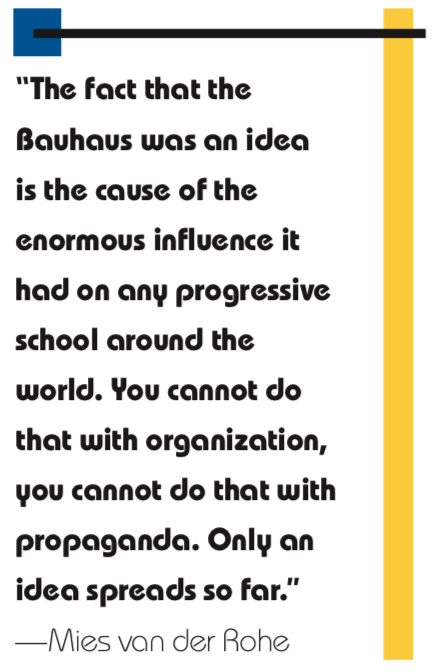The Bauhaus is the Keith Richards of design schools: influential, legendary, and stubbornly refusing to die. The fanfare occasioned by its 100th anniversary is largely deserved—it’s still the gold standard among design schools —but the fact that it was in existence only for 14 years raises the obvious question: Why are we still talking about the Bauhaus? and a more elusive one: Why has no design school superseded its influence in the intervening century?
If we’re talking about the school, rather than the style, we need to acknowledge that there is no such thing as the Bauhaus. The school went through several manifestations during its short existence, so it is only one thing in the same way a caterpillar and a butterfly are one thing: the school that Walter Gropius started in 1919 bears little resemblance to the school Mies would disband in 1933. Gropius’s utopian vision of uniting all the arts under one roof where they could cross-fertilize was the central idea behind its founding, reminiscent of composer Richard Wagner’s earlier efforts to unify all arts via opera into “the total work of art.” This Germanic predilection for overarching visions unfortunately didn’t stop at the arts, which would later factor into the Bauhaus’s undoing.

It was said that Gropius didn’t know how to draw. This seemingly insignificant detail is, I believe, crucial to deciphering the source of the Bauhaus’s influence, for, had Gropius been a virtuoso architect (like Mies), the Bauhaus likely would never have been formed. Gropius was more of an ideas man, the rare individual who can assemble a diverse collection of talented people—which included the eccentric Johannes Itten, who dressed like a monk—to work together toward a common goal. Gropius was the orchestra conductor, and this ability—not his design skills—was his special gift. Since it’s probably been a hundred years since someone could get a group of academics to all pull in the same direction, this, by itself, should be cause for celebration.
But the school never stood still for too long (perhaps a secret to its success). After four years, Gropius abruptly changed course, adopting a new focus on design for mass production; “Art into Industry” was the new motto (the monk would have to go). In this iteration, the designer would harness industrial technology and create well-designed mass-produced goods. Hannes Meyer, Gropius’s successor, took the school in a more overtly political direction, putting an emphasis on “design for the masses” that would become one of the school’s hallmarks but also get Meyer in hot water with the local authorities, who would turn to the apolitical Mies van der Rohe to reboot the school a third time.
If the Bauhaus owes its origin to Gropius, it owes its influence in the realm of architecture to Mies. He doubled down on the Bauhaus’s emphasis on understanding materials, explaining, “No design is possible until the materials with which you design are completely understood,” and, like Josef Albers—who focused on the limits of visual perception—stressed objectivity and a search for “truth” in an extra-moral sense. “Architecture, in my opinion,” Mies would later say, “is not a subjective affair. The tendency should be in an objective direction.” Subjectivity was for painters, not architects, according to Mies, so he redrew the line between the arts and architecture that previous iterations of the Bauhaus had sought so assiduously to erase. The Bauhaus had become an architecture school.

The school was already famous by the time it was shut down by the National Socialists in 1933, enabling its faculty to emigrate across the globe to disseminate its teachings—Meyer to the Soviet Union, Albers to Black Mountain College, and Gropius to Harvard’s GSD, where he promptly gave away the library because students shouldn’t be looking at history books (you’re welcome, Columbia). Ironically, the Nazis’ attempt to destroy the Bauhaus only served to amplify its influence and ensure its legacy. Mies van der Rohe landed in Chicago at IIT, where his stripped-down Bauhaus approach found a welcome home in the no-nonsense Midwest metropolis. Mies’s objective “solutions” to the “problem” of building turned out to be a smash hit with both developers and corporate America, and were subsequently reproduced across the American landscape (but never improved upon), in the same way the German delicacy Hamburg steak became the ubiquitous hamburger here. Speaking in a lecture at the Blackstone Hotel in Chicago in 1953, 20 years after the Bauhaus’s closing, Mies was asked about the school’s enduring impact: “The fact that the Bauhaus was an idea, I think, is the cause of the enormous influence it had on any progressive school around the world. You cannot do that with organization, you cannot do that with propaganda. Only an idea spreads so far.”
And spread it did. Any great idea eventually becomes a victim of its own success, its influence eventually so pervasive that it becomes invisible, and so it is with the Bauhaus. Architecture, its greatest beneficiary, for the most part, has turned its back on Bauhaus doctrine and currently preoccupies itself with the kind of subjective self-expression and vacuous formalism that Mies and his Bauhaus colleagues abhorred. But, elsewhere, the principles of the Bauhaus live on today, hiding in plain sight. For it’s in the iPhone that art meets technology, and the Bauhaus ethos is fully realized—a product for the masses that is functional but beautiful, with clean lines, simplicity, and sophisticated use of advanced materials. It embodies the argument that everything can be improved through design. From the phone itself to its packaging, advertising, and the design of the store in which it’s sold, is it not the “total work of art” that Gropius (and Wagner) imagined?
Though in existence for a mere 14 years, no school since has superseded the Bauhaus’s global impact on architecture and design. But it’s important to remember that it didn’t begin as an architecture school but grew out of an arts-and-crafts movement and ideas about the relationship between art and technology. Architecture wasn’t added as a course of study until 1927. The Bauhaus evolved into an architecture school over time, and eventually transcended the field. It is likely that the next Bauhaus will emerge from an idea about technology, and come from somewhere other than architecture.






